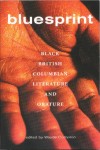 |
Bluesprint: Black British Columbian Literature and Orature
edited by Wayde Compton
Arsenal Pulp Press 2001
Reviewed by Anne Borden
No matter where you go, no matter what country, continent, ice floe or island you land on, you will find someone else black already there.
Quoting BC poet C.S. Griscombeís riff on the old African American saying, editor Wayde Compton introduces Bluesprint, an anthology of black BC literature and orature. The first comprehensive collection of its kind, Bluesprint is an indispensable volume for scholars of Canadian literature and the African
diaspora.
Comptonís anthology provides a documentary history of migration and transformation within British Columbiaís black communities from 1858 to the present. He describes the work as "the tracing of a phantom lineage," charting the waves of migration between Canada, the United States, the Caribbean, Africa and Europe. Like exiled South African poet Arthur Nortje, who made BC his home between 1967 and 1969, many black BC writers have maintained their transnational identities, thus Kingston reverberates through the work of Vancouverís Hope Anderson and we read Saltspring via Cleveland in the work of American transplant Fred Booker.
Bluesprint begins aptly with the 1858 journals of Governor General James Douglas, who passed for white although his mother was black. In 1858, Douglas welcomed the first black migration to British Columbia, 1,000 San Franciscans fleeing increased legal hostility, who sold off several million dollars in U.S. property and boarded the northern steamer Commodore. As Robin Winks notes in The Blacks in Canada: A History, a substantial portion of the pioneer property owners on Saltspring Island were black. Landowning men were able to vote, serve on juries and apply to become British subjects. Skilled and literate, this community fostered the work of gold mine boomtown poets (such as Rebecca Gibbs), community leader-orators (Mifflin Wistar Gibbs) and oral historians like Mary Stark Wallace (1867-1966).
In the early twentieth century, black porters settled an area near the East Vancouver train station ("Hoganís Alley") which for decades served as a locus for black cultural production and civic life. In the nineteen-sixties, facing the devastating infrastructual impact of corrupt city politics and aggravated by increasing black flight to desegregating suburbs, the neighborhood sped into a rapid decline, from which it has not recovered.
Compton dedicates a significant section of Bluesprint to Daphne Marlatt and Carole Itterís collected oral histories of former Hoganís Alley residents (Opening Doors). These narratives offer invaluable discussion of church and club life, Asian-Black relations, labour struggles, and civil rights battles in BC throughout the century. Marlett and Itterís selections also complement the neighborhood paeans of poets such as Fred Booker ("Of Powell Street at midnight/nobody taught me wrong from right/Hey now, there ainít a thing on Main street/to keep a black cat out all night" ). The words of Hoganís Alley residents also offer a background into the contemporary world of crime and pain inhabited by Lawrence Yzhak Braithwaiteís queer gangster gutter punks in Vancouver (Trunk Music).
Braithwaiteís work is brilliant, and represents the distinct voice of black BC literature, a matter-of-fact defiance of traditional ideas about race, class and sexuality in popular cultures and in black literary criticism. As Compton notes, black Canadian identity is not determined by "transplant Afrocentrism, easy access African-Americana or the spice-rack vapidness of [Canadian] liberal multiculturalism". Very little of the century and a half of work in Bluesprint suffers from reactionaryism, misogyny or the banality of identity politics. As an editor, Compton has wisely chosen to embrace writers who name sexual and racial ambiguity, such as Braithwaite, Kathy Ann March, Lily Spence and Andrea Thompson. Each of these authors destabilizes white/black binarism and challenges sexual strictures within and without black community.
In "Mending Clothes as I think of Sojourner Truth" Joy Russell signifies the literary bliss that comes from this bolder perspective ("I am going through the eye of the needle, to/thread, to pull you closer to me, and your name, the image/as you ripped open your shirt, revealed/your brave heart covered by breast".) Other pleasures include Comptonís own poetry, which draws on oral and literary traditions and is remiscent of Leon Forrestís work, and Bluesprintís excerpts of Terence Anthonyís dystopic graphic novel ""Shadowtown".
Comptonís transcription of Vancouver rappers Rascalz points to the need for oral work to be transmitted orally, and ideally a new pressing of the book would include a CD representing the breadth of black BCs oral tradition. In general, Bluesprint points to the work at hand for scholars of Canadian literature and history, exploring the wealth of literature and orature that Compton and others have just begun to tap.
Anne Borden lives in Toronto, where she works
as a writer and editor.
|